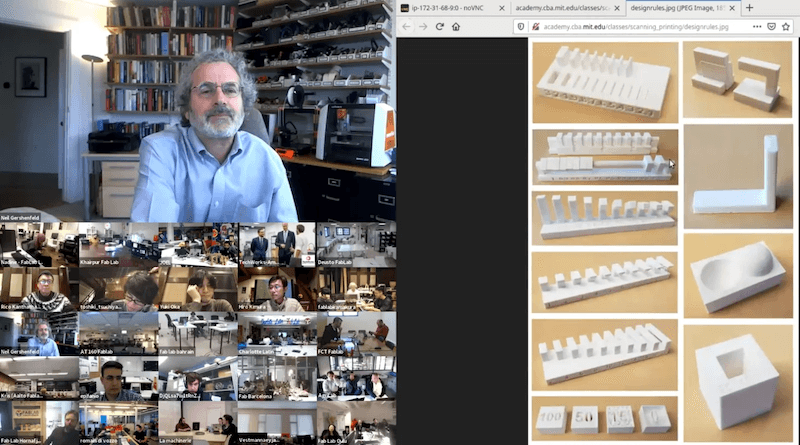At 3 in the afternoon, the Honduras FabLab is being called out by FabAcademy lecturer and founder Neil Gershenfeld, who is at his home in the United States. Honduras hasn’t uploaded their homework for this week. While Gershenfelds mouse shifts over the empty block under ‘Learning how to make cool stuff’, a student in the Metselaarsgildekamer at Waag in Amsterdam sighs. ‘Please don’t waste anyone’s time,’ Gershenfeld says to the Honduras FabLab. He then continues, cheerfully showing a picture of him and his son at a large 3d-scanning unit in Hollywood. In the Metselaarsgildekamer, five students and their instructor Henk Buursen are watching it all happen on the screen.
This January, FabAcademy 2020 started at Waag. Waag has been hosting FabAcademy in its FabLab ever since it was still a pilot back in 2009. These days the FabAcademy is an education trajectory of six months, followed simultaneously by over sixty labs in the world, from Bangladesh to Mexico and from Iceland to Rwanda. Students learn all about digital fabrication, following courses and doing group assignments each week, which are then followed by international review and class by MIT’s Neil Gershenfeld. Students also work on their own final projects. All of this is documented online, so that during the weekly international review, Neil can comment on the various ways in which each FabLab has fulfilled their assignments.
One hundred times more candy
We’re in week four of FabAcademy and the students have completed an assignment on electronics production, making their own 'in circuit programmer' they can use for their upcoming assignments. (Check out what they did). Through videochat, we can see Neil Gershenfeld sitting in his workroom, a dog sometimes casually passes by in the hallway. From his office, Neil has the power to mute and unmute all of the labs who are in the call, which leads to moments where we see two people sitting in a car, or to Neil calling ‘Hello? Is Singapore there?’ The screen stays silent for a while, but eventually Singapore pops up. ‘Nihar, you need to be ready for these reviews,’ Neil says. Then, the student calling in from Singapore scrolls through the photos he took of the assignment this week. Neil opens a Paint-like program and draws a V-shape, commenting on the way in which the student did his milling. The student then gets to present his idea for his final work, which is an automated tea brewer.
Another student in another FabLab shows us his idea for a drone for his final project. Neil Gershenfeld calls in the Barcelona FabLab, where a lady explains that one of their previous contestants made a drone that does ‘seed bombing’ for enhancing biodiversity. We also see Japan, where it is night time, and where a completely different approach was taken to the assignment of the week, using acid instead of milling.
At the end of the review, Neil Gershenfeld asks if people have any questions or remarks. Reykjavik pops into the screen. A man, standing in front of four children dressed in Frozen costumes, explains that the children, as part of local festivities, have to sing to people to earn candy. The four children sing an Icelandic song. They then get applauded by over a hundred people in more than sixty countries. ‘There is one problem now,’ Neil Gershenfeld says, ‘the children now have sung for over a hundred people, so they need to get one hundred times more candy.’
‘You get, just, goo’
After the break, class on the subject for next week starts. We’re talking about 3d printing, following the public course on the FabAcademy website. ‘There’s many constraints in 3d printing. It’s not remotely magic. You don't get to just push go and parts magically come out,’ Neil says. ‘You can get the job running, and when you come back, for an extrusion you get a tangle of spaghetti, for a particle binding you get elamination, for a resin one you get, just, goo.’
We run through the various ways in which 3d printing works – for example: a pointy object always needs a straight line in the design. ‘You don't design in a vacuum, you design around knowing your printer,’ Gershenfeld says. Then, we touch on the subject of 3d scanning, for which Gershenfeld shows many types of scanners. He explains how they work by drawing circles and lines in the same Paint-like program he used to explain copper milling to the Singapore FabLab. For example, one of the photogrammetry scanners works by photographing an object continuously, while at the same time, lighting the object with a speckle pattern, sending out random dots of light towards the object that is being scanned.
Gershenfeld also shows an example of 3d scanning for which the head of president Obama was scanned. This was actually a dangerous thing to do, because the 3d scanned head paves the way for using it for making deep fake videos, as the engineer who made the head also showed in a video for which he worked with an actress.
After the class, the labs from all over the world wave at each other. In India, a little girl, held by her mother, comes in front of the camera and waves goodbye. One by one the labs tune out of the conference call.
The work of FabAcademy 2020 is documented open source. Find the class described in this article here. The review session on electronics production can be found here. And check out the profiles of Waags FabAcademy contestants, in which they describe who they are, what they are learning and what they want to work on for their final projects.


